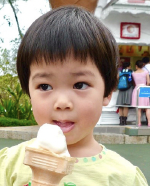If you’re eager for new visual art to admire, look no further than the walls of most campus buildings. Posted on the entryway to the dining hall and the cork boards within Hill House and Humanities are evidence of two photo shoots that have taken place around campus: Eleanor Kim ’19 organized a nature-inspired photo shoot using visual artists, models, and photographers, while Melody Li ’18 composed a photo shoot about waste and consumption.
Kim’s motivation was to illustrate power of makeup in visual art. She said, “I wanted people to understand that makeup can be used in ways beyond the everyday. I want the rest of the campus to see that makeup is an art. That’s something I feel like isn’t recognized.”
Kim’s photo shoot, which took place Sunday, May 14, involved collaboration between visual artists, models, and photographers alike. The event was advertised through posters showing Grant Corso ’18 styled in rainbow makeup. Roshni Surpur ’20, Lily Ball ’20, and Laila Hawkins ’19 acted as models for the event.
Although the photos have not yet been published, Kim said that she, along with Corso, Jade Watson ’19, and Abigail Rivas ’19, plan to make a magazine displaying the photos. The magazine will raise awareness of a makeup-inspired club that Kim hopes to start in the future. Kim said, “In the club, we are going to have a bunch of projects, like the one we just did. Artists will gather together and create visual art using makeup.”
Li’s series of photos, entitled “In Our Genes,” is displayed in the Hill House Dining Hall’s lobby. Li, a student at the Kohler Environmental Center (KEC) was inspired by an end-of-term experience in her English class, where she, along with her fellow KEC peers, aspired to do a creative social action as a whole group. Li’s photos were also inspired by Gregg Segal’s photography project, “7 Days of Garbage,” in which he “personalizes waste by asking his friends and neighbors to save their trash and recyclables for seven days and to lie down with their garbage for a photograph.”
At the end of the seven days, KEC participants were photographed with their trash in poses that they had a large say in. In this way of having the models choose their positions, Li disposes of the “anxiety and helplessness” shown in Segal’s work, and attempts to give off an aura of hopefulness and replenish the “overwhelmingly claustrophobic compositions within our imaginations and stories” that Segal’s work focuses on. Li said,“Each photograph tells a story on its own, and the story goes on to have a life of its own.”



